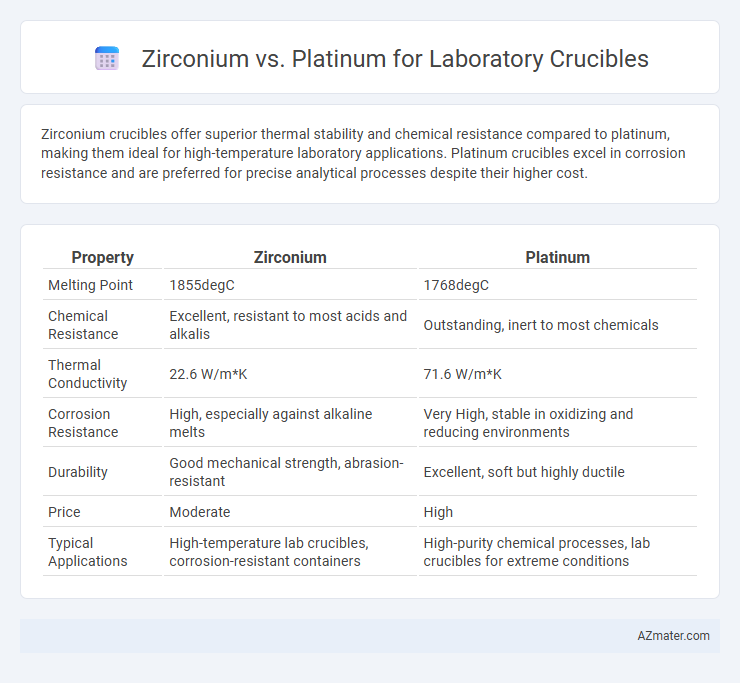Zirconium crucibles offer superior thermal stability and chemical resistance compared to platinum, making them ideal for high-temperature laboratory applications. Platinum crucibles excel in corrosion resistance and are preferred for precise analytical processes despite their higher cost.
Table of Comparison
| Property | Zirconium | Platinum |
|---|---|---|
| Melting Point | 1855degC | 1768degC |
| Chemical Resistance | Excellent, resistant to most acids and alkalis | Outstanding, inert to most chemicals |
| Thermal Conductivity | 22.6 W/m*K | 71.6 W/m*K |
| Corrosion Resistance | High, especially against alkaline melts | Very High, stable in oxidizing and reducing environments |
| Durability | Good mechanical strength, abrasion-resistant | Excellent, soft but highly ductile |
| Price | Moderate | High |
| Typical Applications | High-temperature lab crucibles, corrosion-resistant containers | High-purity chemical processes, lab crucibles for extreme conditions |
Introduction to Laboratory Crucibles
Laboratory crucibles require materials with exceptional thermal resistance and chemical stability, making zirconium and platinum prime candidates due to their high melting points and corrosion resistance. Zirconium crucibles offer affordability and excellent resistance to alkalis and acids, while platinum crucibles provide superior durability and inertness, ideal for high-precision analytical applications. Selecting between zirconium and platinum depends on the specific laboratory conditions, including temperature ranges, chemical exposure, and budget constraints.
Overview of Zirconium Crucibles
Zirconium crucibles offer exceptional chemical resistance and thermal stability, making them ideal for high-temperature laboratory applications involving aggressive substances. Their corrosion resistance surpasses many materials, including platinum, especially against alkalis and strong acids. Zirconium's high melting point and mechanical strength allow safe use in melting, calcination, and heat treatments with minimal contamination risk.
Overview of Platinum Crucibles
Platinum crucibles are renowned in laboratory settings for their exceptional chemical resistance, high melting point of 1768degC, and excellent thermal conductivity, making them ideal for high-temperature applications such as sample melting and chemical analysis. Compared to zirconium crucibles, platinum offers superior durability in aggressive chemical environments, though it comes at a higher cost. Their non-reactive nature and ability to withstand repeated thermal cycling provide reliable performance in precision scientific experiments.
Chemical Resistance Comparison
Zirconium crucibles exhibit superior chemical resistance against highly corrosive acids and alkalis compared to platinum crucibles, making them ideal for aggressive laboratory processes involving molten chlorides and aggressive oxidizers. Platinum crucibles, while highly resistant to oxidation and suitable for high-temperature applications, are more susceptible to attack by hot alkaline solutions and certain halides. The enhanced chemical inertness of zirconium enables longer crucible lifespan and reduced contamination in experiments requiring extreme chemical durability.
Thermal Stability and Temperature Endurance
Zirconium crucibles exhibit superior thermal stability withstanding temperatures up to 2200degC, making them ideal for high-temperature lab applications requiring resistance to thermal shock and chemical corrosion. Platinum crucibles also offer excellent temperature endurance, with melting points near 1768degC, providing exceptional inertness and longevity in corrosive environments but lower maximum temperature tolerance than zirconium. For laboratory use, zirconium is preferred for extreme high-temperature processes, while platinum is favored for precision work involving reactive substances at moderately high temperatures.
Reaction with Common Laboratory Chemicals
Zirconium crucibles exhibit exceptional resistance to corrosion and chemical attack from acids, alkalis, and molten metals, making them suitable for handling aggressive laboratory chemicals. Platinum crucibles offer outstanding inertness and stability, particularly in oxidizing and reducing environments, and resist attack by most acids except aqua regia. Both materials provide reliable performance, but zirconium is preferred for highly corrosive alkaline conditions, while platinum excels in high-temperature applications involving reactive gases and oxidizing acids.
Durability and Lifespan
Zirconium crucibles exhibit exceptional durability due to their high resistance to corrosion, thermal shock, and chemical attack, making them ideal for prolonged laboratory use. Platinum crucibles offer superior lifespan as they withstand extreme temperatures and maintain structural integrity even under repeated heating cycles. Both materials excel in durability, but zirconium provides cost-effective longevity, while platinum ensures unmatched performance in high-temperature applications.
Cost Analysis: Zirconium vs Platinum
Zirconium laboratory crucibles are significantly more cost-effective compared to platinum, reducing expenses by up to 70% while maintaining high chemical resistance and thermal stability. Platinum crucibles, though superior in corrosion resistance and lifespan, carry substantially higher initial costs, often exceeding thousands of dollars per unit. For budget-sensitive laboratories requiring frequent crucible replacement, zirconium offers an optimal balance of performance and affordability.
Application Suitability in Laboratory Settings
Zirconium crucibles offer superior resistance to high temperatures and corrosion, making them ideal for applications involving aggressive chemicals or molten metals in laboratory settings. Platinum crucibles excel in inertness and thermal conductivity, providing precise temperature control for sensitive analytical procedures such as spectroscopy and microanalysis. Selecting between zirconium and platinum crucibles depends on the chemical compatibility, temperature requirements, and analytical precision demanded by specific laboratory applications.
Summary: Choosing the Right Crucible Material
Zirconium crucibles offer high resistance to chemical corrosion and excellent thermal stability, making them suitable for aggressive chemical reactions and high-temperature applications. Platinum crucibles provide superior durability, exceptional chemical inertness, and resistance to oxidation, ideal for ultra-pure sample processing and precision laboratory work. Selecting between zirconium and platinum depends on specific laboratory requirements, balancing cost, temperature tolerance, and chemical compatibility.

Infographic: Zirconium vs Platinum for Laboratory Crucible
 azmater.com
azmater.com